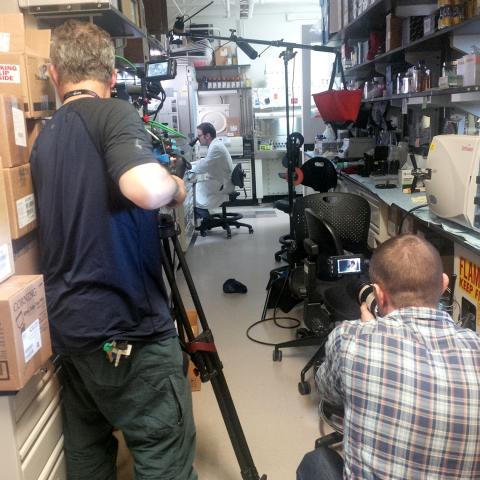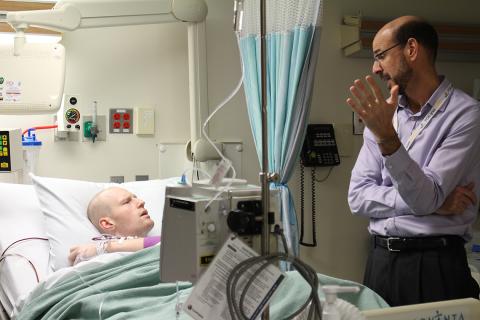‘Trials of Bldg. 10’
Documentary Showcasing CC Set to Air This Spring

Photo: Discovery Channel
Most NIH’ers know about the extraordinary research happening inside the Clinical Center. Soon, the public will also know, thanks to a Discovery Channel documentary.
On May 18 at 9 p.m., the cable channel will begin a 3-part series First in Human: the Trials of Bldg. 10. Directed by John Hoffman and executive produced by Hoffman and Dyllan McGee, the film will chronicle patients, their families, doctors and researchers as patients undergo experimental treatments at the hospital.
Actor Jim Parsons will narrate the documentary, which will air in 2-hour segments.
“The NIH Clinical Center’s more than 60-year history has resulted in remarkable medical advances, from the first use of chemotherapy to treat cancer, to the development of the technique to keep the blood supply clean and safe from viruses,” said NIH director Dr. Francis Collins. “For millions of patients around the world, it is known as the ‘House of Hope.’”
At the CC, every patient is enrolled in a clinical trial designed to answer specific questions about the safety and effectiveness of a new treatment or how a disease progresses and, in some cases, to identify previously undiagnosed or new diseases. Most patients are enrolled in phase 1 trials—also known as first-in-human trials. In many cases, patients enrolled in these trials don’t have any other treatment options.
Since it first opened in 1953, the CC has enrolled thousands of patients. The doctor-patient partnership has resulted in a long list of medical milestones, including the first use of gene therapy to treat a patient and the first use of the antiretroviral AZT to treat AIDS.
“What was most powerful about embedding [film crews] in Bldg. 10 and following these trials was observing how the doctors and patients came to rely on each other in a true partnership to advance medicine,” said Hoffman, who also produced The Weight of the Nation, The Alzheimer’s Project and Sleeplessness in America. All three HBO documentaries featured NIH research.
“Clinical Center staff have much to be proud of when they come to work,” noted hospital CEO Dr. James Gilman. “Everything I’ve heard suggests this series bears that out. Since my arrival on campus, I’ve sensed the excitement around this broadcast. It’s a tremendous opportunity to educate about the NIH mission and biomedical research.”

Photo: Discovery Channel
After months of pre-production scouting and on-site information gathering, crews began filming in September 2015 and wrapped up their most intensive work in May 2016. Spot filming continues. More than 1,000 hours of footage have been collected; hundreds of staff, patients and their families have been filmed, said Justin Cohen, chief of the Clinical Center’s Office of Communications and Media Relations.
Before crews embedded with doctors and patients, they underwent training about patient safety and privacy, infection control and how to put on personal protective equipment, he added.
During filming, crews were always accompanied by staff from Cohen’s office and other IC communications offices or specially trained NIH staff acting as “filming ambassadors.” Sometimes, for instance, they had to troubleshoot for filmmakers or advocate for patients. Cohen called it “an extraordinary opportunity and a real team effort.”
Dr. Lauren Wood, clinical director of the Vaccine Branch in NCI’s Center for Cancer Research, was filmed for the show. She appreciated the time the crew took to get to know the people they were depicting. Discovery employees “were really committed to getting patients and their families’ stories” and “made an effort to be very respectful of patients,” she said.
The crew also focused on getting the science right and capturing “how exciting, challenging and hard it is to do good science with patients,” Wood added.
She enjoyed seeing each crew’s transformation. At first, they were unfamiliar with NIH acronyms and medical terminology. As time went on, they picked up the vocabulary and asked great questions.
There were times when patients’ appointments changed at the last minute, but the film crew easily adapted, she recalled. Things went smoothly because there was real-time coordination between Discovery, the communications staffs of the CC and ICs “and what felt like an infinite number of emails,” she added.
Although she took part in filming, Wood hasn’t seen the documentary.
“I have seen not one thing,” she said. “I’m looking forward to watching it with everyone else and seeing the story unfold.”
